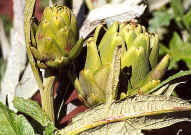|
|
|
|
|
|
Select Compact, plump globes with large, tightly clinging leaves and good green color. Peak season March to May. During spring, artichokes will be globe-shaped; during the summer and fall, artichokes will be more conical with slightly flared petals. During winter, artichokes may exhibit a white blistered or bronze appearance due to exposure to frost. This cosmetic defect does not affect quality , and in fact, enhances the nutty flavor of the artichoke. Avoid artichokes that appear wilted, moldy, significantly discolored, or woody.
Ordering Specifications,
Temperature/humidity recommendation for short-term storage of 7
days or less: Serve Hot, as a separate vegetable course or a vegetable with meat, poultry, fish. Cold, as a salad or appetizer. Nutrition: 1 medium artichoke (8 oz.) = 25 calories
|

